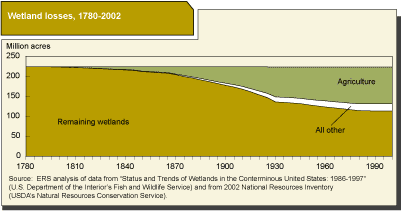In the Long Run
- by Roger Claassen
- 6/1/2004
Wetland losses
Until well into the 20th century, conversion of wetlands to agricultural and other uses was encouraged by policy incentives for drainage and westward expansion. Starting in the 1930s, conservation laws began to slow wetland conversion, and this momentum was reinforced by other measures over the last 30 years. Today, about half of the original wetlands area in the 48 contiguous States has been converted to other uses, mostly agriculture, but urbanization and other uses now account for most wetland conversion. Currently, the rate of net wetland loss from agriculture has been reduced to almost zero.
The current inventory of U.S. wetlands has been influenced by key legal and economic milestones.
- The Swamp Land Acts of 1849 and 1850
- The Homestead Act of 1862
- The Migratory Bird Hunting Stamp Act of 1934
- The Water Bank Program, 1970
- The Clean Water Act of 1972 plus later amendments
- Swampbuster provisions, 1985
- Reduced tax incentives for wetland drainage, 1986
- Wetland Reserve Program, 1990


